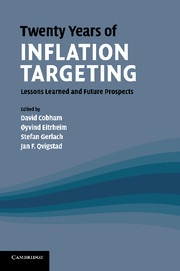Book contents
- Frontmatter
- Contents
- List of figures
- List of tables
- List of contributors
- 1 Introduction
- 2 Welcome remarks: a Norwegian perspective
- 3 Reflections on inflation targeting
- 4 Inflation targeting at twenty: achievements and challenges
- 5 Inflation targeting twenty years on: where, when, why, with what effects and what lies ahead?
- 6 How did we get to inflation targeting and where do we need to go to now? A perspective from the US experience
- 7 Inflation control around the world: why are some countries more successful than others?
- 8 Targeting inflation in Asia and the Pacific: lessons from the recent past
- 9 Inflation targeting and asset prices
- 10 The optimal monetary policy instrument, inflation versus asset price targeting, and financial stability
- 11 Expectations, deflation traps and macroeconomic policy
- 12 Heterogeneous expectations, learning and European inflation dynamics
- 13 Inflation targeting and private sector forecasts
- 14 Inflation targeting, transparency and inflation forecasts: evidence from individual forecasters
- 15 Gauging the effectiveness of quantitative forward guidance: evidence from three inflation targeters
- 16 Macro-modelling with many models
- 17 Have crisis monetary policy initiatives jeopardised central bank independence?
- 18 Inflation targeting: learning the lessons from the financial crisis
- 19 The financial crisis as an opportunity to strengthen inflation-targeting frameworks
- 20 ‘Leaning against the wind’ is fine, but will often not be enough
- 21 Inflation targeting, capital requirements and ‘leaning against the wind’: some comments
- Index
20 - ‘Leaning against the wind’ is fine, but will often not be enough
Published online by Cambridge University Press: 05 October 2010
- Frontmatter
- Contents
- List of figures
- List of tables
- List of contributors
- 1 Introduction
- 2 Welcome remarks: a Norwegian perspective
- 3 Reflections on inflation targeting
- 4 Inflation targeting at twenty: achievements and challenges
- 5 Inflation targeting twenty years on: where, when, why, with what effects and what lies ahead?
- 6 How did we get to inflation targeting and where do we need to go to now? A perspective from the US experience
- 7 Inflation control around the world: why are some countries more successful than others?
- 8 Targeting inflation in Asia and the Pacific: lessons from the recent past
- 9 Inflation targeting and asset prices
- 10 The optimal monetary policy instrument, inflation versus asset price targeting, and financial stability
- 11 Expectations, deflation traps and macroeconomic policy
- 12 Heterogeneous expectations, learning and European inflation dynamics
- 13 Inflation targeting and private sector forecasts
- 14 Inflation targeting, transparency and inflation forecasts: evidence from individual forecasters
- 15 Gauging the effectiveness of quantitative forward guidance: evidence from three inflation targeters
- 16 Macro-modelling with many models
- 17 Have crisis monetary policy initiatives jeopardised central bank independence?
- 18 Inflation targeting: learning the lessons from the financial crisis
- 19 The financial crisis as an opportunity to strengthen inflation-targeting frameworks
- 20 ‘Leaning against the wind’ is fine, but will often not be enough
- 21 Inflation targeting, capital requirements and ‘leaning against the wind’: some comments
- Index
Summary
Thank you for inviting me here to discuss inflation targeting twenty years on. It is now some years since I left active duty in a central bank. Participating in this panel has given me an opportunity, which I very much welcome, to summarise my thoughts on some of the monetary policy issues discussed today.
First, it is important to be clear what we mean when we talk about inflation targeting. Obviously, inflation targeting has to involve a target for inflation. In my world, that target also has to be explicit. I would therefore not think that a country could qualify as inflation targeting ex post – being perceived in retrospect as having tried to reach a target. This is sometimes claimed to have been the case for the Bundesbank, or, more recently, for the Federal Reserve. Acting in this way should be classified as behaving like an inflation targeter, not being one.
I also think that to be an ITer the target should be part of a wider framework, set up to make the bank clear and transparent. One should not only say in advance what one is aiming for, but it should also be possible to follow up in retrospect what has been delivered.
I do not believe that one can underestimate the importance of central banks trying to be open and clear during the recent decade and a half.
- Type
- Chapter
- Information
- Twenty Years of Inflation TargetingLessons Learned and Future Prospects, pp. 434 - 439Publisher: Cambridge University PressPrint publication year: 2010



